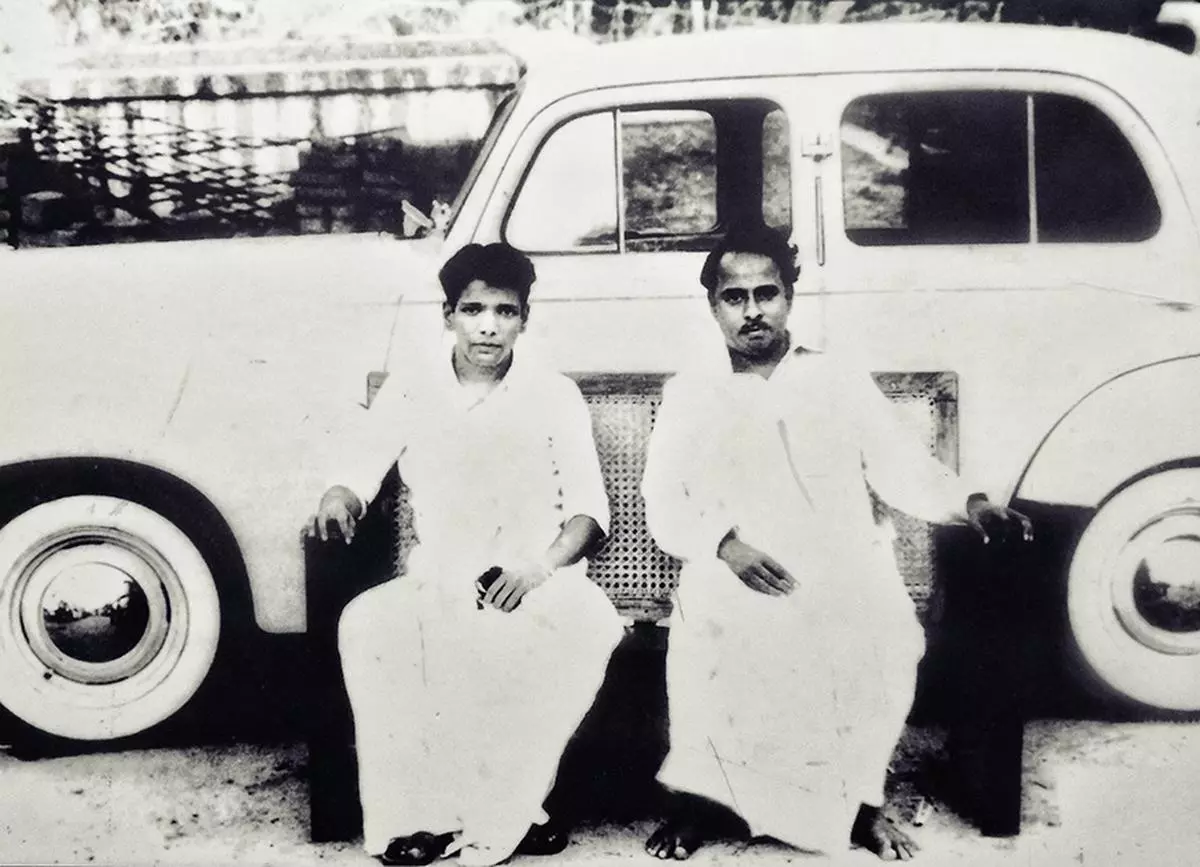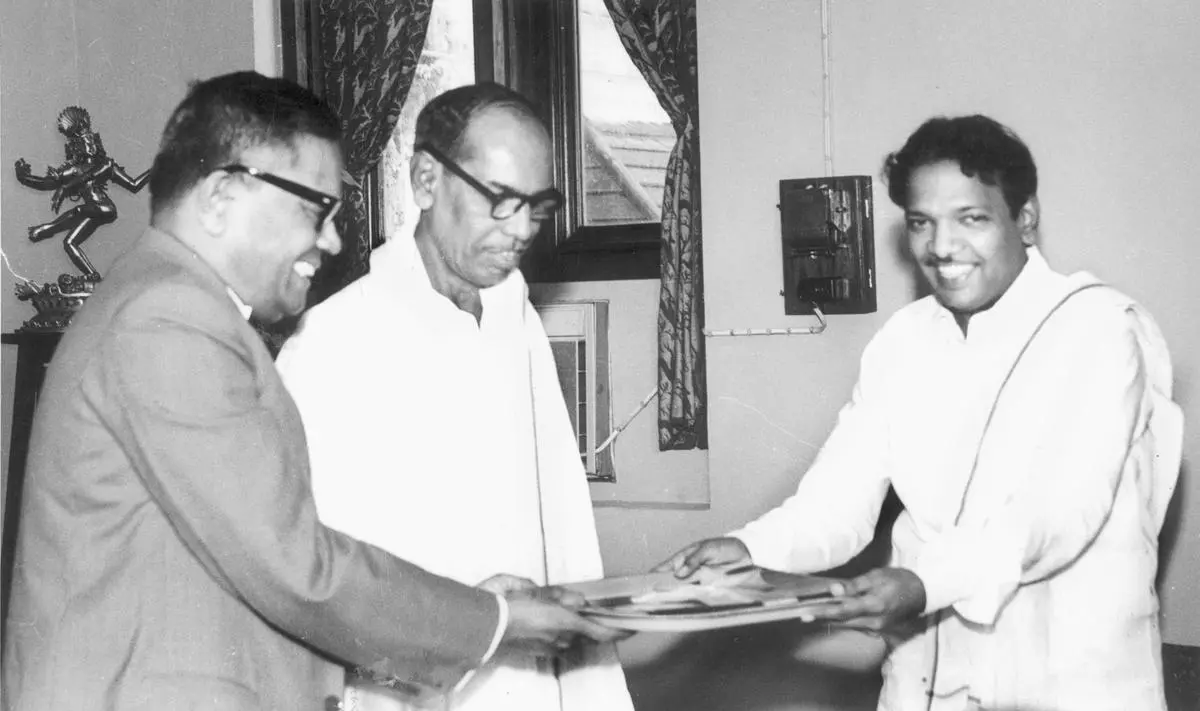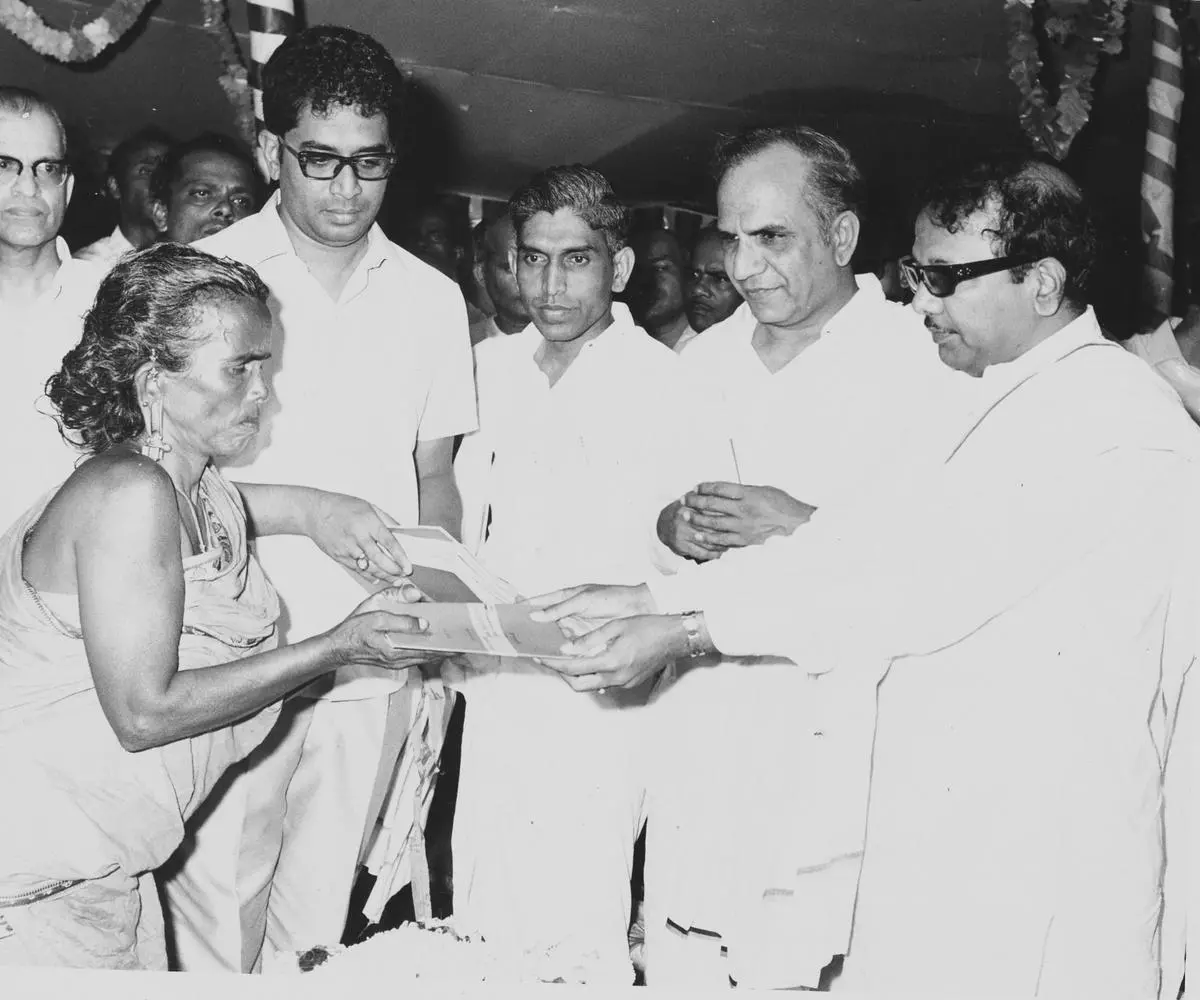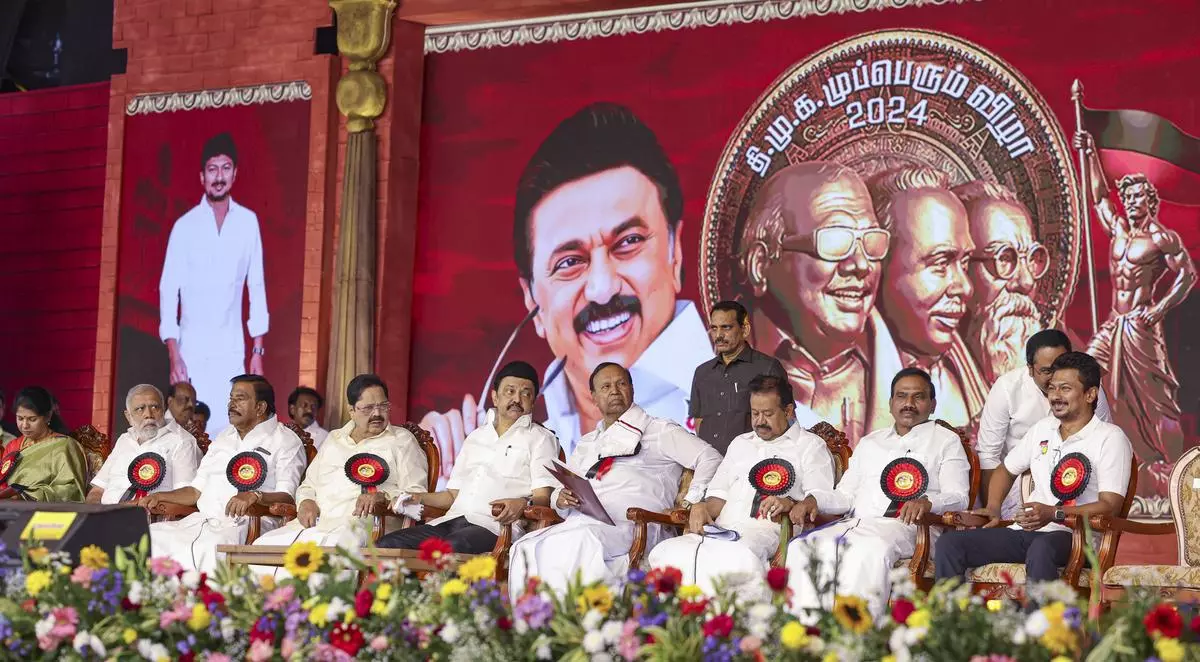
The year-long celebration of the birth centenary of the late Kalaignar M. Karunanidhi, former Dravida Munnetra Kazhagam (DMK) chief and five-time Chief Minister of Tamil Nadu, which concluded a few months ago, has left his party, which also celebrates its 75th anniversary this year, in a jubilant mood. Kalaignar (the moniker means a “scholar of the arts”), who is known for his scholarship, political acumen, and remarkable courage, has left an indelible mark on Tamil Nadu’s political landscape. Despite facing three major splits during his leadership, he managed to keep the DMK united until his death.
When Karunanidhi passed away, many wondered whether the party, without its towering leader, could maintain unity in the face of internal divisions. Yet, in contrast to the fractured state of its rival, the All India Anna Dravida Munnetra Kazhagam (AIADMK), which splintered into three factions, the DMK has emerged stronger than ever. Under the leadership of M.K. Stalin, Karunanidhi’s son, the party remains a formidable political force now.
After breaking away from the Dravidar Kazhagam in 1949 on the question of participation in electoral politics, C.N. Annadurai (fondly referred to as Arignar [scholar] Anna) and his ideological heir Karunanidhi pursued their political career through the DMK. As scriptwriters, both Annadurai and Karunanidhi could propagate the party’s ideology through Tamil cinema. Both were adept in using aphorisms and asides in public discourses. With their main thrust on Tamil language and culture, they cast a spell on their audiences with their oratorical skill, which went a long way in helping the party emerge as an aggressive political organisation that could challenge the well-entrenched Congress party in the 1960s.
The disastrous announcement of Hindi as the official language strongly boosted the political prospects of the DMK. A DMK volunteer being arrested for attempting to burn sections of the Constitution during the party’s anti-Hindi agitation in Coimbatore in 1964.
| Photo Credit:
The Hindu Archives
The Congress’ blunders—such as Rajaji’s unpopular educational scheme, which the DMK dubbed kula kalvi thittam, (hereditary education scheme); the political repression the government unleashed on DMK cadres when they agitated against the rising price of foodgrains in the State; and the disastrous announcement of Hindi as the official language (1965)—strongly boosted the political prospects of the DMK. But a critical analysis shows that these factors alone did not catapult the DMK to power.
The vision of social justice and welfare
At a time when the State was reeling under a severe shortage of foodgrains, the election manifesto drafted by Annadurai targeted a wider section of people. Correctly sensing that their real competitor was the CPI after its striking performance in the 1952 election, both Annadurai and Karunanidhi expanded the DMK’s manifesto to include land ceiling and nationalisation of transport services, which were then part of the CPI’s programme. Speaking in the Assembly on the Budget in 1962, Karunanidhi presented a powerful case for the takeover of private bus companies. One of his first administrative actions on assuming office as Chief Minister was to give effect to it in 1972.
Also Read | Mightier than sword
With the premature passing of Anna in 1969, Karunanidhi, who enjoyed popular support among cadres, managed to steer clear of all inner-party wrangles and successfully took over the party. His commitment to create a welfare-oriented government fetched rich political dividends. He introduced subsidised power for farmers and strengthened the public distribution system by making available domestic essentials such as rice, kerosene, and sugar at subsidised rates in government-run fair-price shops. His expanded welfare schemes included housing for slum-dwellers, pattas and free land to landless Dalits, and access to higher studies for the marginalised and poor sections of the society.

After breaking away from the Dravidar Kazhagam in 1949 on the question of electoral politics, C.N. Annadurai and Karunanidhi (left) pursued their political careers through the DMK. A photograph from Kalaignar Karuvoolam.
| Photo Credit:
VEDHAN M
A series of progressive social laws introduced by his government fulfilled many of the aspirations championed by E.V.R. Periyar. These reforms granted equal property rights to women, recognised inter-caste marriages, institutionalised self-respect marriages, and appointed Scheduled Castes (SCs) as temple priests. Following the landmark Supreme Court judgment in the Champakam Dorairajan case (1951), which upheld the state’s authority to implement reservation policies in education and government jobs, Karunanidhi, a staunch advocate of social justice, acted decisively.
His government set reservation quotas based on the recommendations of the A.N. Sattanathan Commission: 31 per cent for Backward Classes (BCs) and 18 per cent for SCs and Scheduled Tribes (STs). In response to a 1990 Madras High Court judgment, Karunanidhi introduced an exclusive 1 per cent reservation for STs. His commitment to social justice also played a pivotal role in extending significant benefits to marginalised communities such as the Vanniyars and Mukkulathors. After widespread agitations led by Dr Ramadoss of the Pattali Makkal Katchi (PMK), his government granted a 20 per cent reservation for Most Backward Classes (MBCs) and Denotified Communities (DNCs).
The fierce electoral rivalry between the DMK and its breakaway rival, the AIADMK, eventually resulted in 69 per cent caste-based reservation for Other Backward Classes in Tamil Nadu. Thanks to Karunanidhi’s vision, Muslims and Arunthathiyars were granted inner reservation of 3.5 per cent and 3 per cent, respectively, Muslims within BC and Arunthathiyars within SC.
“Landlordism” in Tamil Nadu
But how have the Dravidian parties fared in addressing the socio-economic problems of people who are at the bottom of society? Dravidian ideologues claim that landlordism declined in Tamil Nadu because of Periyar’s Dravidar Kazhagam and land tenure measures adopted by the DMK government under Karunanidhi, downplaying the decisive role of the Congress and the CPI.1 In fact, the idea of tenancy reform was first articulated in the context of the agrarian crisis of the 1930s caused by the worldwide economic depression. With a 50 per cent fall in the price of agricultural produce, rich peasants and landlords were fighting for tax remissions in the Legislative Council, while tenants and landless labourers were left with no choice but to take to the streets to press their demands.
Highlights
- The DMK, under Karunanidhi’s leadership, implemented numerous welfare schemes and reservation policies aimed at social justice, but failed to address deep-rooted caste inequalities in Tamil Nadu.
- Despite land reforms and efforts to uplift marginalised communities, powerful intermediate castes have largely benefited from these policies, leaving many Dalits and lower caste groups still struggling for equitable representation and resources.
- The rise of caste-based political parties and persistent inter-caste tensions pose significant challenges to the Dravidian model of governance, raising questions about its effectiveness in achieving true social equity in Tamil Nadu.
With increasing instances of default, the zamindars resorted to force to collect rent. The tenants resisted, and there were widespread incidents of zamin officials getting assaulted in several zamins of Thanjavur, Ramanathapuram, Tiruchirappalli, and Tirunelveli districts2 as they engaged in rent collection. In view of the colonial government’s indifference to the tenants’ demands for fair rent and security of tenure, some Congressmen who led the tenant struggles in zamin tracts demanded abolition of the zamindari system, which was eventually accomplished after Independence.
During this period of Depression, agricultural labourers struck work across the districts. In several villages, the mirasidars complained that they were not able to extract work from Pannaiyals3 (bonded labourers). For instance, in Palayam village, Nannilam taluk (Thanjavur district), both tenants and agricultural labourers rose in rebellion (1939) against the mirasidar who hired hoodlums to intimidate them. A police sub-inspector, at the insistence of the mirasidar, went to the Dalit quarters along with two constables to put the residents under detention.4 In Ramanathapuram district, the conflict between two agrarian castes of Thevars (tenants) and Devendra Kula Vellalars (landless labourers) led to riots.5

June 1970: A.N. Sattanathan handing over the report of the First Tamil Nadu Backward Classes Commission to Chief Minister M. Karunanidhi.
| Photo Credit:
Courtesy of Ramani Natarajan and K. Pichumani
B. Srinivasa Rao and Manali Kandasamy of the Communist Party launched the Vivasaya Thozhilalar Sangam (Agricultural Labourers Association) in Thanjavur in 1939. In Thanjavur district, there were traditions of joint struggle by sharecroppers and agricultural labourers in the 1930s.6 As attested by the sociologist Saraswathi Menon, this tradition continued even in the 1940s with the setting up of All India Kisan Sabha branches in several taluks from 1943. Menon observed that the abysmal living conditions of innumerable sharecroppers were similar to the wretched plight of the pannaiyals.7
Struggles of the Dalits as a land labouring class
The peasant movement became militant in the face of post-war inflation and the attendant erosion in real wages and increase in rents. Alarmed by the developments taking place in the context of the Telangana peasant struggle since 1946, the Congress government outlawed the CPI and its Kisan Sabhas (Vivasayigal Sangams). In Thanjavur, the peasant leaders were arrested and their offices sealed. Kuppusamy, a member of the CPI of Kalappal, was sentenced to imprisonment. Following his death in jail, there were violent incidents in many parts of East Thanjavur. The police had to resort to firing (April 1948) to quell the violence. In the process, one of the union leaders—Natesan—was killed.8
The prolonged struggles of cultivating tenants and agricultural labourers, however, led to the signing of the historic Mayavaram Agreement on October 28, 1948, “the settlement of which was satisfactory to all concerned”.9 This settlement, according to the anthropologist Kathleen Gough, paved the way for the Thanjavur Tenants’ and Pannaiyals’ Ordinance of 1952 that set the rents of the cultivating tenant at three-fifths of the crop and increased agricultural wages by about two-thirds.x Gough did a field study in Thanjavur villages (Kumbapettai and Kirippur)11 first in 1951-53 and later in 1976.
What Dalits as a land labouring class gained under the communist leadership is detailed by Gough as follows: The Vivasaya Thozhilalar Sangam had 200 members at the time of its inception (1939). It increased to 45,000 in 1973. In 1951, almost all Dalit children worked as agricultural child labourers. However, when Gough returned, she observed a significant decline in child labour and an increase in the number of Dalit children enrolled in school in every village. The wages prevalent in the early 1970s were considered to be the highest in East Thanjavur, and hence, when the Tamil Nadu government appointed a committee for the revision of minimum wages for agricultural workers, it excluded the region from the committee’s purview.12
In 1952, pannaiyals in many villages could be beaten for alleged “defiance and misdemeanour”. In 1976, it had become rare to see a master beating his pannaiyal. In 1952, recalcitrant pannaiyals were forced to drink a solution of cow dung. By 1976, this odious practice had disappeared.13 There was gradual disappearance of the pannai adimai system.14 Since 1952, the public amenities available to Dalit labourers had improved. Most areas had well-built roads, electric street lights, and newly dug wells instead of pools for drinking water. The caste restrictions imposed on Dalit labourers had “considerably reduced”. They could walk freely in the streets and wear shirts and ankle-length clothing (instead of just a knee-length garment earlier).15

Karunanidhi handing over the patta book to a woman farmer at a function in Paramakudi on October 9, 1972.
| Photo Credit:
The Hindu Archives
The struggles of Dalits spearheaded by the communist parties helped end social oppression. Gough attributed the ceiling imposed on land ownership at 30 standard acres in 1961 and 15 standard acres in 1972 to the heroic struggles and sacrifices of the Dalit land labourers. But the government’s poor implementation of tenancy legislation and land ceiling laws in 1961 and 1972 enabled landlords to circumvent them through large-scale benami transactions in connivance with the bureaucracy. Even the meagre surplus land made available for redistribution to the landless agricultural labourers was not suitable for cultivation. The absentee landlords evaded the legislation by selling land to their tenants at a throwaway price. The beneficiaries of land reforms were, therefore, the tenants: Kallars in Thanjavur, Mukkulathor in south Tamil Nadu, and Vanniyars16 in north Tamil Nadu. Many political analysts are of the view that the domination of Dravidian parties in electoral politics has become possible only due to their alliance with these powerful caste groups, to the detriment of the interests of Dalits.
The numerical preponderance of Brahmins in landownership is indisputable. But there was also a sizeable number of landlords belonging to the Mudaliyar, Moopanar, Vellalar, Naidu, Udaiyar, and Kallar communities. Before the enforcement of the land ceiling Act, in the central part of the district where landlordism was dominant, Brahmin landlords possessed between 1,200 to 2,000 acres, while non-Brahmin landlords had land to the extent of 15,000 acres.17
When the sociologist André Beteille visited Sripuram (Thanjavur district) in 1962, a village chosen for his study, he found that temples, gram panchayats, and cooperative societies once controlled by Brahmins were under the control of the non-Brahmin landed gentry. In Sripuram, Beteille noticed a Kallar leader functioning as president of the local gram panchayat. Beteille wrote that although Vellalars and Kallars were in equal numbers, the latter dominated the village politics in view of their numerical strength in the adjoining villages.18 In 1976, even after land reforms had been executed in two spells, Gough found many families owning 100 or more acres of land. She also came across three family estates with more than 3,000 acres and several more with about 500 acres. These landlords, through benami transactions, had registered lands in the name of their tenants or labourers.19

Tamil Nadu Chief Minister and DMK president M.K. Stalin along with the party’s senior leaders at the “Mupperum Vizha”, held to mark the 75th anniversary of the DMK, in Chennai on September 17.
| Photo Credit:
PTI
Caste and “confrontation” politics
Whether it was Congress rule or the rule of the Dravidian parties, the struggles—both on class or caste lines—continued to be treated as a law-and-order problem. Like the AIADMK in 1995, the DMK was discomfited by the outbreak of caste violence in south Tamil Nadu in 1997. Karunanidhi, treating it as a law-and-order issue, established the southern zone Inspector General office in Madurai. Sociologists point out that wherever people live under unjust social conditions and are therefore deprived of the chance to realise their full potential, structural violence is inevitable.
The Justice Party, the precursor of the Dravidian movement, proclaimed itself as a non-Brahmin Party. Non-Brahmin is not a homogenous group. In the context of Tamil Nadu, those in the forefront of Justicite politics were elites drawn from communities such as Mudaliars, Chettiyars, and Vellalars, who patently belonged to the upper strata of the non-Brahmin group. The party hardly represented larger social groups such as the Vanniars, Nadars, and Mukulathors (Thevars). So, the Communal GOs of 1921 and 1922, over which the Dravidian parties take pride today, were helpful only to the elites of the minority non-Brahmin strata.
In 1969, nearly after four-and-a-half decades of the introduction of the reservation policy, the A.N. Sattanathan Commission, set up by the Karunanidhi government, found “nearly 70 per cent of the population of the cultivating castes i.e., Padayachi, Kallar and Maravar… more than half the Kaikola population and smaller castes including barbers and washermen, living in conditions of abject squalor and under conditions hardly distinguishable from those prevailing amongst the Scheduled Castes before Independence”.
After another 20 years, the Ambasankar Commission in its report (1983) pointed out that of the total number of BC students admitted to professional courses, more than three-fourths were from a small number of BCs (34 out of 222).20
In the wake of the Vanniyar agitation spearheaded by the PMK of Dr Ramadoss, Karunanidhi introduced 20 per cent reservation for MBC-DNC. Vanniyars, as reported in The Hindu recently, have since cornered a major part of the seats in the MBBS course.21
Whether they belong to BC or SC, a large number of caste subgroups still feel left out, as the State’s reservation policy has resulted in an uneven distribution of the originally intended benefits.
Also Read | Karunanidhi on RSS
Dr Ramadoss’ success with caste-based mobilisation soon prompted all main caste groups to have political outfits. The New Justice Party (Mudaliyar), the Kongunadu Makkal Katchi (Gounder), the Puthiya Makkal Tamil Thesam Katchi (Yadavas), and the Samathuva Makkal Katchi (Nadar) are notable examples. Failed by the mainstream political parties, Dalit people have rallied behind their caste leaders under the banner of parties such as the Dalit Panther Party, the Tamilaga Makkal Munnetra Kazhagam, Puthiya Tamilakam, and the Aathi Tamizhar Peravai.
With lower representation for socially deprived communities in seats of power and the denial of their rightful claim to equal treatment in state patronage, Dalit parties find themselves increasingly uncomfortable with their alliance partners. Their feelings of despair are further fuelled by the continuing caste atrocities on Dalits by intermediate castes. Inter-caste animosities rising out of institutional power sharing have intensified “confrontation politics” in Tamil Nadu, which may soon drive the State into a crisis of governability.
It remains to be seen whether the government under Stalin can address these structural challenges, especially considering that the State aspires to be a model of social justice governance.
K.A. Manikumar is a retired Professor of History at Manonmaniam Sundaranar University, Tirunelveli.
Notes and References
1 Jeyaranjan, J. (2018): “Decline of Landlordism”, Frontline, August 21, 51-58.
2 For details read, Manikumar, K.A. (2003): A Colonial Economy in the Great Depression: Madras, 1929-37, Chennai: Orient Longman, 171-172.
3 Thomas, P.J. and K.C. Ramakrishnan, South Indian Villages: A Resurvey, University of Madras, 1937, 141.
4 G.O. 4030 Home 24, July 1939. Quoted in Manikumar, K.A., A Colonial Economy in the Great Depression, 175.
5 Manikumar, K.A., A Colonial Economy in the Great Depression, 173-175.
6 Ibid., 173-175.
7 Menon, Saraswathi (1979): “Historical Development of Thanjavur Kisan Movement: Interplay of Class and Caste Factors”, Economic & Political Weekly, Annual Number, 403-408.
8 Alexander, K.C. (1978): Agricultural Labour Unions: A Study in Three South Indian States, Hyderabad, 26.
9 The terms of agreement included fixation of daily wage of pannaiyals at one Marakkal and women labourers at 3/4th Marakkal and regularisation of normative functions of the pannaiyals. See Alexander, K.C.: Agricultural Labour Unions, 27.
10 Gough, Kathleen (1983): “Agricultural Labour in Thanjavur”, Social Anthropology of Peasantry, John P. Mencher (ed.). Bombay: Somaya Publication, 284.
11 Kumbapettai and Kirippur are fictitious names, the former in the western part of Thanjavur and the latter situated 3 miles away from Palakurichi.
12 Gough, Kathleen: “Agricultural Labour in Thanjavur”, p. 276.
13 Ibid., 286.
14 Ibid., 218.
15 Gough, Kathleen (1981): “Agrarian Change in Thanjavur”, Kerala and Madras: A Comparative Study of Ecology and Social Structure, John P. Mencher, Trivandrum, pp. 15-30.
16 Until the Dalit Panther Party emerged as a strong political force.
17 Ibid.
18 Beteille, André (1996): Caste, Class and Power: Changing Patterns of Stratification in a Tanjore Village, Oxford University Press.
19 Gough, Kathleen: “Agrarian Change in Thanjavur”, 287.
20 Manikumar, K.A. (2021): “Reservations Then and Now”, Frontline, December 17, 70-74.
21 Ramakrishnan, T. (2024): The Hindu, August 4.



